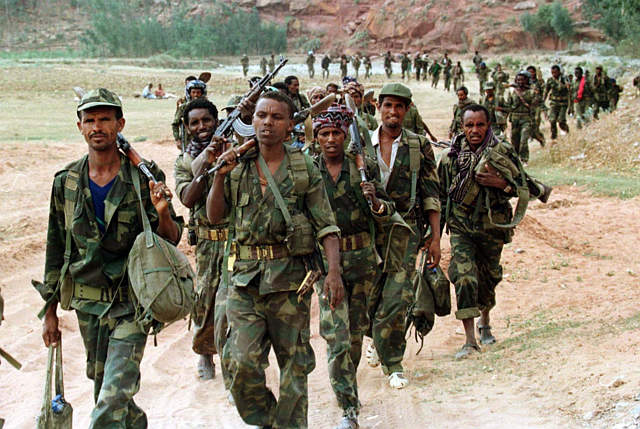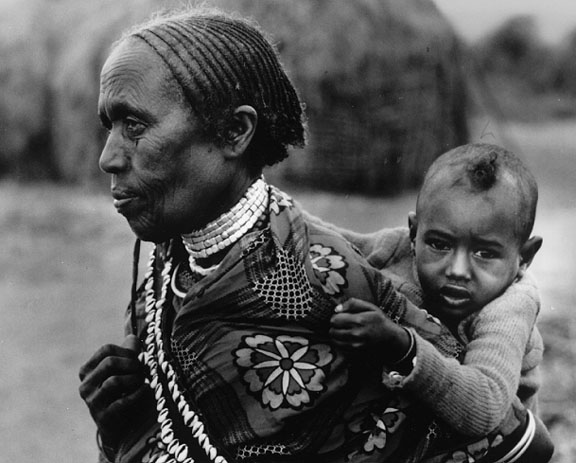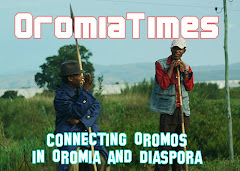Ethiopian girl survives troop massacre
NAIROBI, Kenya | The teenager awoke under a pile of corpses to a pricking sensation on her face. Ants were biting her eyelids and the inside of her mouth.
Photo: TPLF/EPRDF forces marching in Ogadenia (OromiaTimes collection)
The pain, however, brought relief to the 17-year-old. “I thought, I’m alive,’ ” Ridwan Hassan Sahid remembers. She felt blood oozing from rope burns around her neck and the weight of a body against her back. But fearing that the Ethiopian soldiers who had left her for dead in a roadside ditch would return, she quickly brushed away the ants, shut her eyes and slipped back into unconsciousness.
The assault and miraculous escape is one of the most chilling stories to emerge from an unfolding tragedy in eastern Ethiopia that largely has escaped the attention of a world transfixed by the humanitarian crisis in neighboring Sudan’s Darfur region.
Ever since exiting colonialists arbitrarily stuck a triangle-shaped wedge of land with 4 million ethnic Somalis inside Ethiopia’s border, violence and suffering has plagued the region. Now, many of them have been caught up in a war between the Ethiopian government and a separatist group known as the Ogaden National Liberation Front.
Hundreds of civilians have been killed and tens of thousands were displaced in the past year alone, although exact figures are unknown because the area is remote and Ethiopian officials restrict access to humanitarian groups and journalists.
Survivors such as Sahid offer the only glimpse into the unfolding tragedy. Now living in a secret location, the petite young woman shared her story recently.
Now 18, Sahid at times seems to be an average teenager, picking absent-mindedly at her henna-stained fingernails and blushing when strangers express interest in her. But behind her soft brown eyes is a weariness that belies her age, and a necklace of scar tissue rings her throat where the rope cut into her skin.
She recounts her ordeal without emotion. Only occasionally does her veneer crack long enough for a tear to roll down her check, which she self-consciously laughs off and wipes away.
“I wonder sometimes,” she says, “what kind of life I can have now.”
She grew up in the village of Qorile with eight siblings. The family, like most everyone else in the area, were semi-nomadic cattle and sheep herders.
Ever since she can remember, Ethiopian authorities were seen as the enemy.
“We feel as if we are living under occupation,” she says. “We grew up afraid of them.”
The Ogaden conflict dates to the 1940s, when after World War II European nations lost or began to relinquish their colonies in the Horn of Africa. After some years under British administration, Ogaden and surrounding areas were placed under Ethiopian control, but the decision was never accepted by the ethnic Somalis living there, spurring two wars between Ethiopia and Somalia and spawning a string of rebel movements seeking autonomy or unification with Somalia.
Ethiopian officials accuse the Ogaden rebels of using terrorist tactics. In April 2007, the rebels killed more than 70 people at a Chinese-run exploration facility in the region.
The attack prompted what aid groups and witnesses call a heavy-handed response by the Ethiopian government. Troops are accused of burning down villages believed to be sheltering rebels, forcibly recruiting young men into government militias, raping women and imposing a commercial blockade that sent local food prices and malnutrition rates soaring.
“They used mass indiscriminate measures to collectively punish the entire population,” Human
Ethiopian officials deny any widespread human-rights abuses and blame rebels for the violence. “They are working with internationally known terrorists,” said Zemedkun Tekle, spokesman for Ethiopia’s Information Ministry.
Sahid says her family tried to stay out of the fray: “We are not political people.”
But she found herself caught in the middle in July, when several hundred Ethiopian troops surrounded her village. Her father was away tending animals in the fields, and her mother was shopping in a nearby town. Sahid was washing her face when soldiers kicked in the door that morning.
“You are guerrillas,” they shouted as the ransacked the house, stealing food and supplies, Sahid remembers. She escaped out a back door and huddled with other frightened villagers. Soon soldiers gathered them all at a water well and began reading names from a list of “spies” and rebel sympathizers.
“Nobody knew who would be selected, but you knew if your name was called, you would be killed,” says Fathi Abdulla, 22, a cousin from the same village. Sahid froze when she heard her name called. She and 10 others were taken to the town’s school, which became a makeshift prison for interrogation and torture. “They took us one by one,” Sahid says.
Soldiers accused Sahid of bringing supplies to rebels. They tied her hands and legs together behind her back. “They kicked me and stepped on my back,” she says. “I told them that in my whole life, the only person I’ve ever helped was my mother.”
The next morning, Sahid and the other prisoners were marched for hours to another village. “They beat us like animals when we couldn’t keep up,” she says. “Mentally, I was already dead. I was just waiting to die.”
Arriving at the village, Sahid says she watched as soldiers looted the town and burned down all the huts. That night, none of the prisoners slept, fearing what the next day would bring.
At daybreak, without explanation, soldiers began executing them, Sahid says. Two were hanged from trees. Two others were choked with metal rods and rope.
Sahid was the last attacked. She remembers hearing the others scream and beg for mercy but couldn’t move or make a sound herself. “At that point, I was like a tree. I had no feeling. I was like a statue.”
Two soldiers ordered her into to the ditch, but she refused. Finally one pounced, strangling Sahid with a metal rod used to clean guns. They struggled for a minute, but she did not lose consciousness and the soldier gave up.
Next, two exasperated soldiers grabbed the girl and tied a rope around her neck. They pulled in different directions until she collapsed into the ditch.
The next thing Sahid remembers were the ants. Blood streamed from her nose and neck. Her legs were trapped under a man’s naked body. She says she closed her eyes again, uncertain whether she would live or die.
Back in her village, friends and family formed a search party, following the soldiers’ footprints to find Sahid and the others. They expected to recover nothing more than bodies.
After several hours of walking, a group of nomads told them about a nearby field with some bodies. Remarkably, they said a young girl was still alive. “We rushed to the place,” Abdulla says. The scene was grisly. Two men hung from nooses in a tree. Other victims lay naked, with belts and ropes still around their necks.
Sahid was in the ditch, under two other bodies. “As we came closer, she opened her eyes and looked at us! We were so shocked.”
They moved her under a tree but feared the girl soon would die. They buried the other bodies and awaited help. Eventually camels were brought and friends began a weeks-long journey to secretly move Sahid out of the country.
She remembers little of the escape or her recovery. She still can’t use her right hand because of nerve damage from the beatings.
With an uncertain future, Sahid spends most days indoors. Venturing outside sometimes brings panic attacks. She says the quiet moments are the hardest to bear. “Whenever I sit for even a minute, I draw my mind back to those events. And I start to cry.”
www.kansascity.com
Rights Watch researcher Leslie Lefkow said.


















2 comments:
Hey there! I've been reading your blog for a while now and finally got the courage to go ahead and give you a shout out from Atascocita Texas! Just wanted to say keep up the great job!
Feel free to surf to my blog: hawaiian
is attempting to throw the Christian i - Phone users demographic a bone.
At a fast glance stone often looks like an utilized cameo, however upon closer
examination one can determine it to be stone.
It seems to me Apple is just looking out for their own public image.
Look at my blog web site
Post a Comment